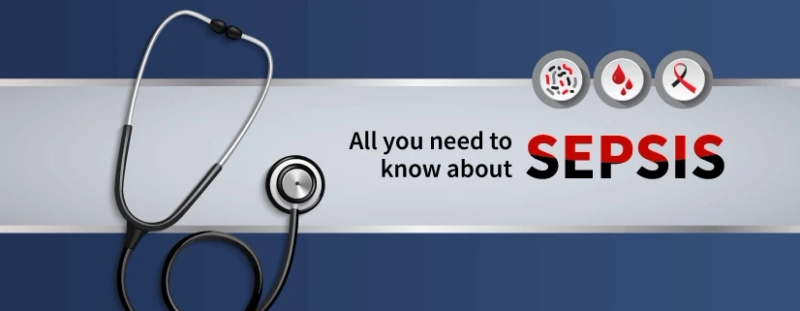When the body reacts to any infection of an organ and starts damaging its tissues, it develops Sepsis, a potentially fatal illness. Organs start performing inappropriately when the body\'s infection-fighting mechanisms are activated. Sepsis may quickly cause tissue severe damage, organ failure, and death if not treated in a timely manner.
What Causes Sepsis?
Any kind of infectious pathogens that enters the body or toxins released by the pathogen has the potential to induce Sepsis. The infection may just affect a single organ, or it may spread via circulation to the entire body. The influenza virus, bacteria that cause gastrointestinal and urinary infections, and streptococcus pneumonia are some of the most common pathogens that cause Sepsis.
Stages of Sepsis
Sepsis can be categorized into three stages,
- Sepsis: Your body experiences inflammation as a result of an infection that enters your bloodstream.
- Severe Sepsis: Organ function is beginning to be impacted by the infection and inflammation.
- Septic Shock: A severe sepsis complication, known as septic shock, results in a considerable decrease in blood pressure. This may result in a number of grave issues, such as failure of the respiratory or cardiovascular systems, organ dysfunction, heart failure, stroke and possible death.
Symptoms of Sepsis
There are a variety of symptoms since Sepsis can develop in a variety of places on the body. Most common symptoms of Sepsis are as follows,
- Rapid Heartbeat
- Fever or Coldness (very low body temperature)
- Feeling Shaky or Cold
- Skin that is warm, clammy or sweaty
- Dizziness or Disorientation
- Shortness of Breath or Fast Breathing (Hyperventilation)
Symptoms of Severe Sepsis
Organ failure is a major result of Severe Sepsis. To be diagnosed with severe Sepsis, you must exhibit one or more of the following symptoms,
- Having trouble breathing
- Skin that is blue in tone, especially the lips, fingers, and toes
- A dip in body temperature that causes chills and reduced urine
- Dizziness
- Alterations in mental capacity
- Absolute weakness (asthenia)
- Reduced platelet count (thrombocytopenia)
- Abnormalities of the heart
- Unconsciousness
Signs and Symptoms of Severe Shock (Septicemia)
Severe sepsis and septic shock can develop from Sepsis very fast. It gets increasingly dangerous to your life as it changes. Some severe sepsis and septic shock symptoms, such as abrupt disorientation, blue skin, and severe trouble breathing, can coexist. Very low blood pressure is another significant sign of septic shock.
Risk Factors of Sepsis
Even while certain individuals are more susceptible to infection, everyone can get Sepsis. The following people are most at risk:
- Adolescent and Elderly
- Patients with compromised Immune systems, such as those living with HIV or receiving chemotherapy for cancer
- Intensive care unit patients (ICUs)
- Those who have been subjected to intrusive equipment like breathing tubes or intravenous catheters
Diagnosis of Sepsis
The Best Internal Medicine Specialist will prescribe tests if you exhibit signs of Sepsis in order to identify and assess the severity of your illness. The test performed would include,
- Blood test
- Wound secretion test
- Mucus secretion test.
A blood test is one of the initial evaluations. Your blood is examined for issues like,
- Issues with infection clotting
- Abnormal kidney or liver performance
- Lowered oxygen levels and an electrolyte imbalance that affects your body\'s water content and blood acidity
Your doctor may order other tests depending upon your symptoms and the results of your tests.
Treatment of Sepsis
If ignored, Sepsis can swiftly turn into septic shock and cause death. Sepsis Treatment In Hyderabad often includes professionals prescribing the following drugs,
- Antibiotics are given Intravenously (IV) to combat the illness.
- Drugs that raise Blood Pressure (BP)
- Insulin to maintain blood sugar levels
- Inflammation-reducing corticosteroids and painkillers for discomfort
If it is a severe case of Sepsis, large amounts of IV fluids, as well as a respirator for breathing, may be required. If the kidneys are affected, dialysis may be necessary. In rare circumstances, surgery may be required to eliminate the infection\'s cause. This could entail removing diseased tissue or draining an abscess that is filled with pus.
Recovery
The extent of your Sepsis and any other underlying medical conditions will determine how quickly you recover. In contrast, many people recover completely, but some experience long-lasting repercussions. According to the UK Sepsis Trust, it takes about 18 months for people who’ve had Sepsis to start feeling their normal selves again. Around 50% of those who have had Sepsis undergo a condition called Post-Sepsis Syndrome (PSS), which can cause long-term effects such as insomnia, nightmares, fatigue, and damaged organs.
Prevention
By stopping the spread of infection, you can lower your chance of developing Sepsis. This is more crucial than ever in the current COVID-19 outbreak. Here are some precautions that you can take to prevent infections,
- Take your vaccinations on time.
- Practice good hygiene, including washing hands frequently and taking proper care of a wound.
- Get immediate help if you have been experiencing any symptoms of Sepsis.
By now, you must have a got detailed idea of Sepsis and all its related aspects. It is crucial to keep the symptoms in mind and reach out to the doctor if you experience them. Take timely action to prevent or treat this infection effectively.
0



